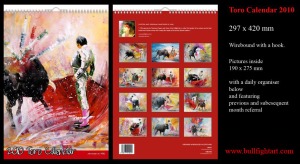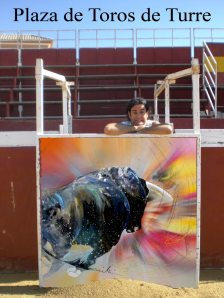Since then, even if I don’t fight the bulls any more, I stood of course in the Taurean milieu, the big passion of my life. Close to Arles where I live, I now have a bull breeding farm (“Los Galos”) which boasts more than 150 head.
As for the future, I would like to become a bullfighters agent and then director of an arena- As Simon Casas did in Nimes.
Will I succeed?
I don’t know, but what I do know is that I will try my best to reach it, in the same way I did it it all my life. And there is no reason that it should not happen: if I succeeded in becoming the first woman bullfighter on horseback in France, why shouldn’t I be able to reach these new goals which are mine today? With passion and work -much work- I sincerely believe that nothing is impossible. My way of life proves it, I think.
I am often asked if I am proud to have been the first woman bullfighter on horseback in France.
I am not especially proud of me, for me. Happy and touched, yes, absolutely, but proud… What seems more important to me is that I could cause some young girls to dream. To transmit to them my passion and to give them the lust to enter this magnificent career. If I were able to create vocations and to open doors, then I would be very happy.
I think that it is easier today than in my time, even if the level has considerably ameliorated. Not only because I have contributed to it. But also because the Taurean milieu – which was so macho, sexist and conservative- slowly opened itself. Probably because they have understood that it is in their own interest, especially in these times when the anti-bullfight lobbies become more and more structured, powerful and influential.
Bullfight, even if it is still very popular in the south, has not reached a national popularity.
The arguments of “the antis” are always the same: barbarism, butchery, cruelty, violence…
I hear them and I try to respect them. Having said that, I would like that these people have a more global and above all more cultural view of bullfighting.
Bullfight, at least for us, is an art. It means sublime lights, magnificent colours, choreography filled with grace, music… A feria is a feast, a communion, an extraordinary ambience which cannot leave anybody indifferent.
Bullfight is an art of living and a culture. And culture, whether you like it or not, you have to respect it.
“The antis” only speak of the sort reserved for the bulls. I want to answer them:
First of all, the animal will die, one day or an other, it is a certainty. Like cows, chicken, whatever. And since man is man, he is a carnivore.
Then you must understand that nobody respects the bull more than the bullfighter himself. He grew and lived with him, he profoundly loves him. Today I am a bull breeder, as I said, and I can testify that I care for my herd with infinite love and attention.
This will make some people smile, but nevertheless it is true. So true that it is not rare that certain animals, -considered as especially brave- are saved. One never speaks about that…
A bullfighter is neither a bully, nor a sadist who persecutes the animal. For that man, nothing is worse than to miss the death blow. The death blow by the way, when it is achieved according to the laws of this art, leads to an instantaneous death. No pain then.
There is a deep respect which ties the bull to the man. And these are not just words, they are the reality of the arena.
To caricature bullfight as “a circus game” is as simplistic as to attribute it to some act of butchery. Running the risk of repeating myself I have to say again that it is all infinitely richer and more subtle. It is certainly not a coincidence that so many writers, film makers, and famous intellectuals dedicated magnificent works to the bullfight world, which still serve as references. Neither a coincidence that in spite of all the pressure, the ferias nowadays still show “complete” and that no-one can deny the fascination of the public.
That one does not approve bullfight is something I hear and respect.
I would simply like that some people make more efforts to understand and accept that culture which is ours. In its global nature and its history. And not only by the thin end of the wedge. I am not pleading here, everybody is free to think what he wants. My words are only the words of a woman who had the luck and happiness to enter this noble family of the Tauromachy. The words of a passionate woman happy to have made some people dream, vibrate and to have caused vocations to bloom.
END













